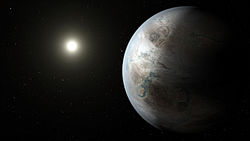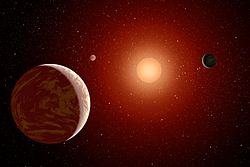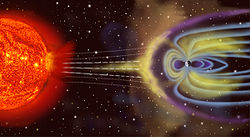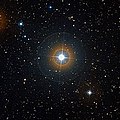Habitability of yellow dwarf systems defines the suitability for life of exoplanets belonging to yellow dwarf stars. These systems are the object of study...
36 KB (3,558 words) - 21:46, 23 May 2025
theorized habitability of red dwarf systems is determined by a large number of factors. Modern evidence suggests that planets in red dwarf systems are unlikely...
47 KB (5,676 words) - 01:13, 25 May 2025
Circumstellar habitable zone Habitability of yellow dwarf systems Planetary habitability Circumbinary planet "Earth-Sized 'Tatooine' Planets Could Be Habitable" (Press...
10 KB (1,156 words) - 14:28, 17 April 2025
habitable zone Habitability of F-type main-sequence star systems Habitability of neutron star systems Habitability of red dwarf systems Habitability of...
10 KB (972 words) - 05:08, 30 November 2024
scenarios. Habitability of red dwarf systems Habitability of K-type main-sequence star systems Habitability of yellow dwarf systems Earth analog List of Kepler...
12 KB (1,387 words) - 17:05, 24 May 2025
Astrophysics in December 2017. Habitability of red dwarf systems Habitability of K-type main-sequence star systems Habitability of natural satellites Neutron...
5 KB (575 words) - 03:55, 31 October 2024
main-sequence star systems Habitability of neutron star systems Habitability of red dwarf systems Habitability of yellow dwarf systems Habitable zone for complex...
139 KB (13,879 words) - 19:12, 24 April 2025
satellites Habitability of orange dwarf systems Habitability of red dwarf systems Habitability of yellow dwarf systems Hypothetical types of biochemistry...
69 KB (3,839 words) - 09:44, 30 May 2025
Planetary habitability in the Solar System is the study that searches the possible existence of past or present extraterrestrial life in those celestial...
54 KB (6,092 words) - 13:07, 23 May 2025
can be viewed as a special case of the latter, if the deadly probes are only sent to star systems that show signs of intelligent life (e.g. due to resource...
15 KB (1,472 words) - 19:16, 30 May 2025
G-type main-sequence star (redirect from Yellow dwarf star)
also often, and imprecisely, called a yellow dwarf, or G star, is a main-sequence star (luminosity class V) of spectral type G. Such a star has about...
12 KB (1,170 words) - 14:37, 20 March 2025
Kepler-1649c (category Near-Earth-sized exoplanets in the habitable zone)
Kepler-442b LHS 1140 b List of potentially habitable exoplanets Proxima Centauri b TRAPPIST-1 e Habitability of red dwarf systems Earth analog "NASA Exoplanet...
9 KB (882 words) - 15:07, 16 May 2025
solar system are also known as exoplanets. As of 30 May 2025, there are 5,912 confirmed exoplanets in 4,409 planetary systems, with 993 systems having...
9 KB (813 words) - 17:27, 15 May 2025
differentiate natural satellite habitability and additionally extend their habitability outside the planetary habitable zone. Liquid water is thought by...
38 KB (3,779 words) - 14:38, 17 April 2025
case of the Berserker hypothesis, if the 'deadly Berserker probes' are (e.g. due to resource scarcity) only sent to star systems that show signs of intelligent...
7 KB (781 words) - 19:30, 4 September 2024
yellow dwarf systems – liquid water on yellow dwarf star Habitability of red dwarf systems – liquid water on red dwarf star Planetary habitability in the Solar...
48 KB (5,264 words) - 15:57, 6 February 2025
the world is found to harbor lifeforms capable of developing intelligence. Multiple planetary systems are planned to be implemented as the game's active...
23 KB (2,793 words) - 23:59, 23 May 2025
extraterrestrial life of the fictional planet Darwin IV in the style of a nature documentary. Although closely following Barlowe's depiction of Darwin IV, Alien...
12 KB (1,448 words) - 06:22, 1 December 2024
that an absence of detectable Von Neumann probes is contrapositive evidence that no intelligent life exists outside of the Solar System. This idea was...
8 KB (753 words) - 17:49, 24 May 2025
F-type main-sequence star (redirect from Yellow-white dwarf)
is referred to as a dwarf star, this class of star may also be termed a yellow-white dwarf (not to be confused with white dwarfs, remnant stars that are...
11 KB (1,247 words) - 22:46, 22 January 2025
Manoj M.; Haberle, Robert M. (1999). "Habitability of planets around red dwarf stars". Origins of Life and Evolution of the Biosphere. 29 (4): 405–24. Bibcode:1999OLEB...
36 KB (4,265 words) - 18:28, 17 May 2025
Former dwarf planets Asteroid belt BD+20°307 Formation and evolution of the Solar System Giant-impact hypothesis Interstellar medium List of stars that...
16 KB (1,509 words) - 20:00, 19 March 2025
Habitability of natural satellites – Measure of the potential of natural satellites to have environments hospitable to life Habitability of red dwarf...
111 KB (13,139 words) - 08:12, 30 May 2025
273: on the formation, dynamical evolution, and habitability of a planetary system hosted by an M dwarf at 3.75 parsec". Astronomy & Astrophysics. 641:...
117 KB (5,481 words) - 14:46, 12 May 2025
to Hoth. Gliese 581 c Gliese 581 g OGLE-2005-BLG-169Lb Planetary habitability List of coolest exoplanets Brennan, Pat (May 1, 2019). "Meet 8 'Star Wars'...
14 KB (1,300 words) - 19:07, 17 May 2025
prototype of the L dwarfs, is one such system. Such systems can be useful in determining the age of the system and the mass of the brown dwarf. Other white...
166 KB (18,261 words) - 02:27, 1 June 2025
form of intelligent life in the universe. There is no reliable or reproducible evidence that aliens have visited Earth. No transmissions or evidence of intelligent...
4 KB (390 words) - 01:19, 20 March 2025
Solar System has at least nine dwarf planets: Ceres, Orcus, Pluto, Haumea, Quaoar, Makemake, Gonggong, Eris, and Sedna. There are a vast number of small...
224 KB (21,986 words) - 04:36, 29 May 2025
dwarfs among the hundred star systems nearest the Sun. The unusual faintness of white dwarfs was first recognized in 1910.: 1 The name white dwarf was...
154 KB (17,962 words) - 15:07, 27 May 2025
K-type main-sequence star (redirect from Orange dwarf)
main-sequence stars ("red dwarfs") and yellow/white G-type main-sequence stars. They have masses between 0.6 and 0.9 times the mass of the Sun and surface temperatures...
13 KB (1,425 words) - 20:20, 10 March 2025




















